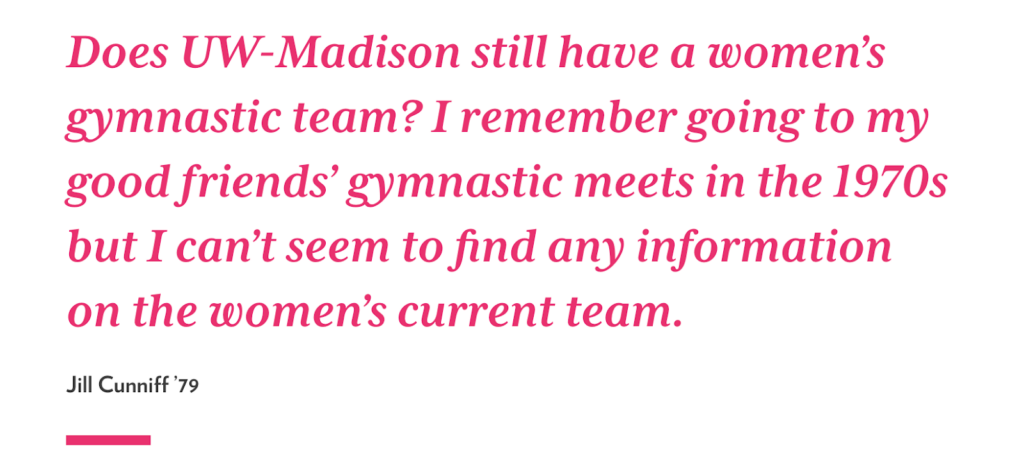College is an exciting and new time for many students.
It’s a time for growth, exploration, and trying new things. For many, that means discovering new passions or reigniting and continuing old ones. For some, it means leaving part of their life behind—for many gymnasts, this is their sport.
Gymnasts who do not play in a college division are often forced to let go of their love of a sport as they graduate high school due to the lack of intramural gymnastics. Former competitive gymnast Mia Blackwell seeks to shed light on the difficulties high school gymnasts face when transitioning to college without the opportunity to continue the sport they love.
Intramural sports are recreational sports that are organized within a particular institution or community. They are designed to promote physical fitness and socialization among students, faculty, and staff. Intramural sports programs typically include popular sports such as basketball, soccer, and volleyball, but often neglect niche sports such as gymnastics.
The lack of intramural gymnastics programs in college is a significant issue. Gymnastics is a demanding sport that requires a significant amount of dedication, discipline, and training. So, for student athletes like UW-Madison senior Mia Blackwell, who dedicate years of their life to a sport, they are then forced to say goodbye to it when entering college.
Unfortunately, many colleges do not recognize gymnastics as a popular sport, and as a result, fail to provide adequate resources for students interested in participating. That being said, some schools have non-advanced gymnastics opportunities but they lack adequate promotion on college campuses.
Furthermore, most people don’t know about the Wisconsin Gymnastics Club. The club was founded in 2002 to fill the void that was left after the varsity gymnastics program was cut in the early 90s. It is an all-level, co-ed program that practices off-campus and participates in the National Association of Intercollegiate Gymnastics Clubs (NAIGC) sanctioned competitions, according to recwell.wisc.edu.

The UW-Madison NAIGC sanctioned gymnastics club joins together to promote their club. recwell.wisc.edu
Most UW students, even those involved in the Recreation and Wellbeing department, aren’t informed about this because gymnastics is such an unrecognized sport at the intramural and club level.
Former Recreation and Wellbeing worker Maggie Dobbins touched on the fact that to host an intramural gymnastics program would be very expensive. The equipment can be costly, and many colleges and universities do not have the necessary budget. This is an important contributing factor to consider. Maggie also reflected on the lack of awareness for gymnastics opportunities at UW.
“I actually wasn’t aware of this club, probably because no one ever expresses interest in pursuing gymnastics,” Maggie said. “I think it’s easy to neglect seeking out opportunities because it’s clear that we don’t have the facilities to support an intramural or club league here.”
Moreover, while the lack of readily available facilities is a deterrent for gymnasts, there is a stigma in the gymnastics community that after high school, that those who don’t play at the collegiate level end their gymnastics careers. Mia loved participating in gymnastics for eight years and ended her career when she began college at UW.
“I never tried to seek out club or intramural gymnastics in college because it’s just so uncommon to carry on the sport past middle and high school,” Mia said. “For women, in particular, your physical capabilities tend to peak between 16 and 19 years old. For many, once you reach that age and aren’t elite gymnastics or olympic material there’s very limited opportunities or options for you to continue the sport.”
Gymnastics is an extremely technical sport that requires a significant amount of dedication, discipline, and training. It’s a sport that demands precision, balance, strength, and agility. Unfortunately, many colleges do not recognize gymnastics as a popular sport, and as a result, fail to provide adequate resources for students interested in participating, meanwhile gymnasts are letting go of a huge part of themselves.
“The physical capabilities the sport gave me was my favorite part of being a gymnast,” Mia said. “Outside being in the gym and competitions, my everyday life still consisted of feeling like a superhuman. I can’t think of any other sport that enables you with such comprehensive abilities.”
Aside from the many benefits that a readily available intramural gymnastics program would give gymnasts, it would also benefit colleges and universities. Especially with the lack of intramural college gymnastics nationwide, a university looking to attract more students could benefit from this opportunity, especially with the growing popularity of the sport. By providing a gymnastics program, colleges and universities could attract a wider range of students and increase the diversity of their student body.

UW-Madison Alumna Jill Cunniff ‘79 expresses her interest in the lack of gymnastics at UW in a Wisconsin Alumni Associate column. uw.alumni.com
Sports are such an important part of many students’ lives. It is beneficial for your mental and physical health and for many is a big part of weekly socialization. Students who participate in popular sports like soccer and basketball have the opportunity to participate in club and intramural leagues, but gymnasts often have to let go of this integral part of who they are.
“I think it’s so important to offer more intermediate opportunities for gymnasts post-high school,” Mia said. “For the majority of gymnasts, guys or girls, their entire life. Their best friends, peers, and overall social life revolves around the sport just for it all to come to an abrupt halt.”
